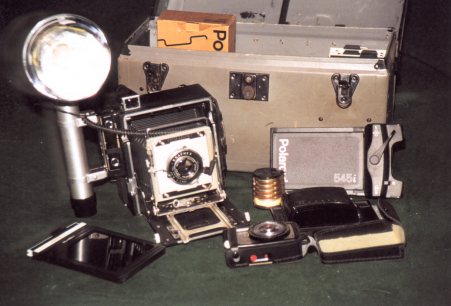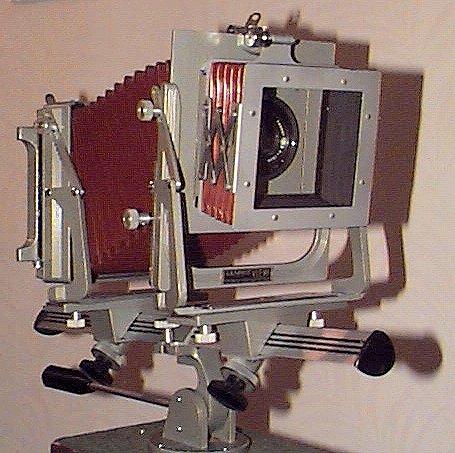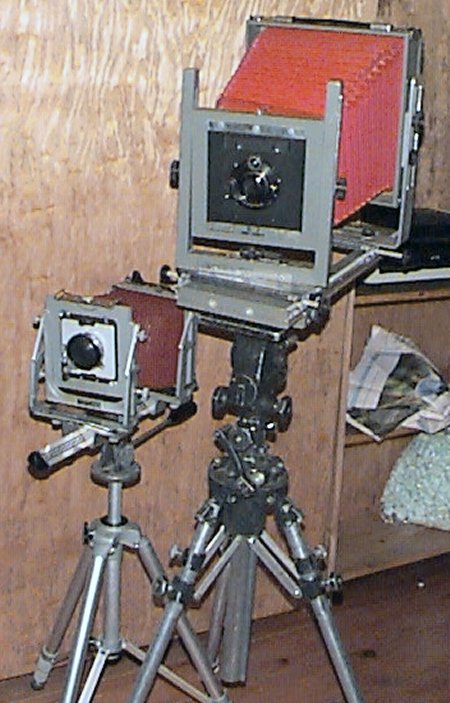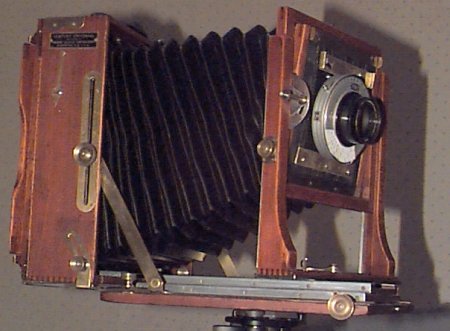
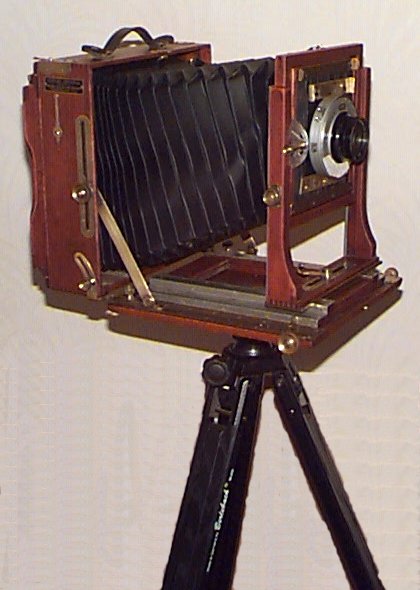
Personal Photo Equipment
and the Jiffy Calculator (at bottom of page)
| I will (not)soon have descriptions and pictures up of the camera equipment I use for my photography. This is not to 'show off' anything, but more just for the curious as I use old equipment that some consider 'collectable'. Since there are other web sites dedicated to this equipment, I won't overdo it, but showing what I use and letting others who own the same equipment know that I too am using this stuff may be of interest... And sorry that things haven't really been updated as they should.. I just can't find the time to update this site as it should be done. | |
| Just in case anyone can help, here's a few items I'm searching for...
A(nother) Century Universal 8x10 camera! A spare 4x5 Super Graphic (must be functional and affordable). The off-camera sensor cable for the Minolta Auto 450 Flash. A PM focusing screen for the XK. A compendium lens shade for the GVII. Polaroid 8x10 81-06 film holders (maybe not so much any more :( ). |
|
|
For 35mm, I use several Minolta XK cameras. They have either standard AE or AES finders with 'P' screens (some with PM screens...). I use two so I can have one loaded with black & white and the other color. I also have X-570's, X-700's with motor drive and multi-function back and an XE-7. There's a decent assortment of lenses from 17-28mm, 18mm, 28mm, 50mm, 75-260mm, 28-200mm, 100-500mm, 500mm CAT, extension tubes and the Auto Bellows I with 100mm & focusing rail for close-ups. Flash is supplied by Minolta Auto 450's, Vivitar's 283's and Sunpak Super 622's.
I also use medium format with a Mamiya C330 twin lens 6x6 cameras. This has lenses of 55mm, 80mm, 135mm, 180 Super and 250mm. I use the waist level finder and the CDS Porofinder. This camera needs no add-ons for doing close-ups, but I do have the Paramender to aid in paralax correction. I do B&W almost exclusively with this camera. If you use, or plan to, a C330; I highly recommend investing in a #7 screen. The #7 was the latest screen produced for the 330's and has a split screen in the center surrounded by a microprism ring. It's much brighter and clearer than the other screens and even makes the Porofinder a pleasure to use. I understand that B&H still sells these new, although on special order for a very reasonable price. Or try KEH which occasionally has them for sale. Any 330 screen will fit any other 330 except for the 330S. Mamiya changed the design slightly for some odd reason in the 'S' models. A good grip (as seen in the pic above) certainly helps too since the 330's are a bit awkward without it. The cameras are backed up with Sekonic L-718 ambient/flash meters and Gossen Luna Pro F's. Both include the spot attachments and attachments for direct ground glass measuring.. A Minolta Spotmeter F is also used for the View cameras. And of course Sekonic L-398M Studio Deluxe IIs and a Gossen DigiFlash in the portable kit. I also use 4x5 format with a 1950's Pacemaker Speed Graphic, Super Speed Graphic, Crown Graphic and Graphic View II cameras. So far, I have a Graphlex Optar 135mm f4.7 in a Wollensak/Graflex shutter, a 90mm f6.8 Raptar in a Wollensak Rapax shutter, a Kodak 10" f6.3 Commercial Ektar in an Ilex No.4 Acme shutter, a Linhof Schneider-Kreuznach Tele-Xenar 360mm f5.5 in a Compound shutter. There's more lenses, but why bother listing them all? (which really means they're put away in their cases and I'm too lazy to go and get the details or update the page ;-) Other accessories include a Grafic 23 6x6 roll film back, a Calumet C2N 6x7 roll holder, Polaroid 545i and Pro backs, Grafmatic backs, Graflex 3 cell bulb flash, Graflex Strob 250 and 500 RG.... There's also a Graflarger back that works great again. (New lamps are available!). The Speed and Crown are great 4x5 field camera systems and someday soon I hope to get some decent pics up here from them.
Next up, in more ways than one, is a Burke & James Commercial View Camera in 8x10. A very nice camera in excellent condition sitting on top of a Majestic tripod (replaced by a lighter wood Berlebach). The camera needed just a little bit of tender loving care to get it back in shape. The tripod, some minor repairs. Both are ready for work... The lens on the B&J is a Hugo Meyer Plasmat in 15.3cm f/4.5, 22cm f/8 and 32cm f/11. A really neat lens! I also have a Turner & Reich convertible in 12,19 and 25 inches, a Wollensak 8x10 Series IIIA EXWA 6 1/4 inch, a Symmar 240/420 convertible and a Nikkor 120/8 primarily for the 8x10 camera. The lens board is home made out of plywood. It's a 6x6 to 4x4 adapter allowing me to use the same lenses on the 8x10 as the 4x5. The Polaroid processor is almost visible on the shelf in the background. The B&J is sitting next to the 'spare' Graphic View II for a size comparison. Despite knowing better, this all made me realize that an 8x10 camera is NOT twice the size of a 4x5 ;-) Yes, it is 4 times the size, and weight, and that goes for all the accessories too!... Saving the best for last, I have a Century Universal 8x10 camera.
Shown here on top of a Berlebach 4032 tripod with a Gundlach Rapid Rectigraphic12-21-28 convertible lens. The lens is mounted in an Ilex Universal #4 synched shutter on a 4 inch board, in a 6 inch adapter board I made so I could keep most of my lenses available for the Graphic View II. This camera is an earlier model with a single front tilt mechanism and a replacement bellows. I'm now working on a second CU that's a bit newer with the dual tilt mechanisms (both sides of the lens board) and the original red leather bellows. This is without a doubt my dream camera.. Took me years to get one. Months to get it in working order. This one is just about ready to go. The Century Universals were made from about 1925-28 through the 1930's by the Folmer Graflex company in Rochester, NY. It has generous movements, folds up compactly for travel and is very light (less than 10 pounds in comparison to the 16 pound B&J above) Made of cherry wood and brass with almost 30 inches of bellows. The B&J above can barely handle a 5 inch lens. The CU could technically handle a 2 1/2 inch lens! But try finding one that covers 8x10... And for the short lenses, the rear case can rise up and slide over the focusing rails all the way to the front so they won't show in the image. What a design! The father of the all metal Kodak Commercial View. Many cameras borrowed from it's design. Some improved on them. But as far as I'm concerned, none beat the Century Universal! I have quite a few other cameras, some working, some not ;-) And even one digital camera that I use occasionally for quick shots (like those above) when I don't want to go through the processing/scanning routine. Black & white work I do myself. Color is sent out. I do some color work but don't have the expensive darkroom equipment so I either don't get the results I'd like or just don't want to go through all the work. It's good for the blow-ups though... For more information about the Minolta XK line, visit The Minolta XK SLR Camera - Index Page , it contains all the info and pics of equipment. For the Mamiya C330 (and other TLR's), visit Mamiya C330 Twin Lens Reflex Camera site. For Graphic/Graflex systems, a visit to graflex.org is a must! If you're into older equipment and the used market, see my Used equipment links page for a list of good dealers and other sites of interest. Just in case you're wondering... Yes, I could afford new auto-everything cameras. I just don't like them! The more automated cameras get, the less of a photographer we become! You could argue till you're blue in the face, but you can't change my opinion! I always carry a point & shoot small camera with me for quick shots (snap shots). Over the years I have found far too many situations where "auto" just doesn't cut it. I've missed some great shots with auto cameras trying to shoot through windows. Got great pictures of the window! Metering is another whole story. Auto focus? How the heck does the camera know what _I_ want to focus on? What happens if your battery goes dead? Try hooking up your auto focus camera to a telescope. Most AF cameras won't work at all unless there's an AF lens connected to it... And don't even start me on digital. It's not better or even as good and overall more expensive no matter what they tell you. People have just lowered their expectations to that level and that's all there is to it! Anyone who uses the phrase "digital darkroom" is just trying to fool themselves, you and justify the expensive equipment. It's "digital imaging" and always has been, not photography! In photography, no two prints can possibly be exactly the same. They're made by hand, one-by-one with slight variations in time, processing, temperature, exposure, etc. If you buy/sell a photograph it wil be a true "original" like any other piece of art work. With digital, the question is 'how many copies do you want' when the print button is pressed. They are all identical and can be dupliacted exactly any number of times, at any time now or in the future. There is no such thing as a digital original! Forget it. I'll stick with old manual cameras that let _me_ do the photography and if I do happen to miss a great shot because I wasn't quite fast enough, well that's life and luck... I'll add my opinion to a lot more people out there who feel the same way, auto cameras kill the photographer. digital isn't photography.. Kind of like an artist doing 'paint by number'! Thanks for visiting South Bristol Views and let us know what you think! |
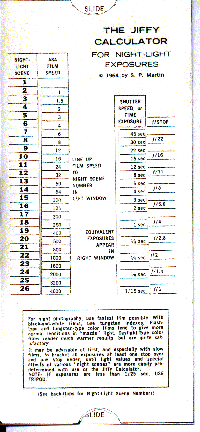 |
Here's an old time treat. Back when I was young, a great photography magazine published this "Exposure calculator" by S.P. Martin. It uses a 'slide' inside the folded paper sleeve to determine the proper exposure for a long list of described situations. I got a lot of use out of this years ago. I recently found the old one and thought I would share it with those who might remember it, or never have seen it... I did do a web search and could find no other reference to this 'device'. I created an Adobe 'PDF' format file that will print the calculator out. All you have to do is cut along the lines, fold the two sides and place the 'slide' inside. Click in the pic at left or here for the Jiffy Calculator.
(For some odd reason, the link to the Jiffy Calculator has been broken. It should work fine now). Also check out the new SBV Bellows Extension Calculator for large format close-ups. |
To get around our site, just click on one of the menu items above.
Visitor Number:
Send e-mail to Rich
Modified -
Entire site contents
© 1999-2017 South Bristol Views
